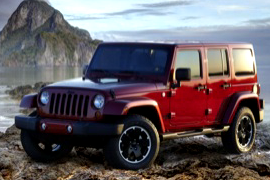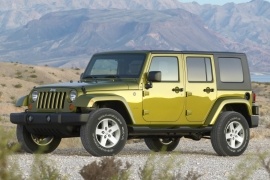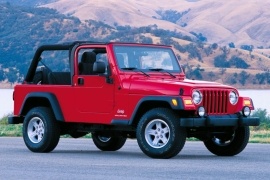JEEP Wrangler Unlimited Models/Series Timeline, Specifications & Photos
First production year: 2004
Engines: Diesel, Gasoline
Body style: SUV (Sports Utility Vehicle)
Jeep introduced the fourth generation of its well-known Wrangler in 2018 and offered it in two wheelbases and also added the Rubicon flavor to it.
The Wrangler Rubicon was the most off-road capable vehicle in Jeep's inventory. With the four-door, long-wheelbase version, it became even more appealing for families. Thus, everybody could enjoy the great outdoors.
At first sight, there were not too many changes in the car's shape when compared with its predecessor, the JK-generation. And yet, subtle modifications such as the more tilted windscreen, the LED headlights and fog lamps, and the rounded shapes were a clear statement of evolution. In addition, at the back of the car, Jeep installed a rear-view camera directly on the cradle that supported the spare wheel. From its profile, the exposed hinges and the high ground clearance were also a signature mark for the Rubicon as it was the seven-slat grille for the Jeep brand.
While the exterior featured subtle changes, the interior was an important evolution. There were much nicer materials inside the Rubicon Unlimited. Jeep even offered an option for a leather-wrapped dashboard. Yet, the bucket seats at the front and the flat bench in the rear didn't provide any side support. The driver, on the other hand, could enjoy the start-button feature and the Uconnect infotainment system. In addition, a mix of digital and analog instrument panels provided all the information needed while driving.
Just like its predecessors, the Wrangler relied on a sturdy chassis. Its stabilizer bars could've been disengaged for higher axle mobility. Moreover, the front and rear diff-locks were fitted as standard on the Rubicon version. Under the hood, Jeep installed a choice of three engines: a 3.6-liter V6, a 2.0-liter turbocharged gasoline unit carried over from Fiat and a 3.0-liter turbo-diesel. All of them were available with either a six-speed manual or an eight-speed automatic.
When Jeep introduced the JK Wrangler in 2007, it surprised everyone with the Unlimited version, but by 2011 standards, it had already started to show its weaknesses, so the automaker updated the rugged SUV.
After the world financial crisis, most automakers found themselves in a weak spot, and Chrysler’s finances were in the red zone of the charts. With some help from the European automaker Fiat, who bought some stakes in the American car manufacturer in 2009, Jeep upgraded the Wrangler’s third generation. In 2010, the automaker improved the interior, and in 2011, it brought the complete package for the 2012 model year, along with a new Pentastar engine, a new transmission, and a slightly different styling. The Wrangler was still available in a few grades, starting with the Sahara and ending with the mighty Rubicon and a choice of two bodyworks: the short-wheelbase and the Unlimited. While the former was a breeze to drive and park in tight spots in cities, the latter was an excellent companion for traveling with up to five people onboard without ruining everyone’s mood due to lack of legroom.
At the front, depending on the grade, the 2012 Jeep Wrangler Unlimited featured a bumper different from its predecessor, featuring the fog lamps placed towards the center of the vehicle. Its recessed headlights and tilted rearward, body-colored, seven-slat grille remained the same. The fenders, on the other hand, were carried over from the Rubicon lineup, with a gap between their front side and the bumper. Particular detail was added to the windshield, which sported a silhouette of a Wrangler climbing over rocks on its lower right-side corner.
From its profile, there were several subtle modifications depending on the options. Customers could equip the SUV with a body-colored hard top with removable panels above the occupants. The automaker provided the Wrangler Unlimited with full-length side steps that eased ingress and egress to the vehicle. Out back, the swing-out rear door, side hinged, supported the spare wheel, like all the other Wrangler generations before it, the CJs and the legendary Willy’s.
The cabin, which was refreshed in 2010 for the 2011 model year, featured new seats, door cards, and a fresh dashboard. It was a completely different vehicle, fitted with thicker and better sound insulation pads. As a result, the cabin was quieter, especially when the hard top was installed. Fronting the driver was an instrument cluster fitted with large dials for the speedometer and the rev counter and flanked on their outer sides by the fuel level and temperature gauges. All of them were encircled by chromed trims. Atop the center stack, Jeep placed a Uconnect multimedia system developed together with Fiat. It featured navigation and a touchscreen. It could connect to phones via Bluetooth, and the driver could use the buttons on the steering wheel to answer or close calls, select music stations, and access other data from the car’s onboard computer.
However, the most significant upgrade was found under the hood. There, Chrysler dropped the former 3.8-liter cast-iron engine and installed an all-aluminum, quad-cam, 3.6-liter powerplant. The new unit produced 83 more hp (85 PS) and better mid-range torque, essential for off-road excursions. Finally, a five-speed automatic transmission with a shorter ratio for the first gear replaced the previous four-speed gearbox. Thanks to these improvements, the Wrangler could outperform its predecessor in all areas, including acceleration time and fuel efficiency. For the European market, the 2.8-liter turbodiesel remained the only option.
Jeep launched the third generation of the Wrangler, the JK, in 2006 at the North American International Auto Show, and along with the already-known three-door model, the automaker brought a five-door version.
In 2004, Jeep tried to see if there would be any interest in a long-wheelbase version of the Wrangler, the LJ, and customers were delighted. As a result, for the 2007 model year, along with the introduction of the JK, the American automaker introduced a five-door, long-wheelbase variant of the vehicle. Even though the Unlimited version came with a worse break-over angle than its three-door brother, it provided enhanced comfort for passengers. In addition, the driver didn't have to choose between luggage and friends in the cabin when going camping. The Wrangler finally became an adequate companion for school runs and travels as well. Jeep managed to upgrade the vehicle but without losing the main advantages of the rugged off-road SUV. It was still a body-on-frame construction, but it came with all the dedicated features, making it a desirable car for adventures.
At the front, the automaker placed an entirely new fascia compared to its predecessor, even though, at first sight, they looked the same. Still, the recessed headlights, the tilted seven-slat grille, and the round turn signal lamps placed underneath the headlamps were new. In addition, the automaker added plastic protection for the metallic bumper to comply with the new safety standards for pedestrian protection.
From its profile, the Wrangler Unlimited had the same front area as its three-door sibling up to the B-pillars. Unlike its predecessors, which featured flush door handles, the JK generation came with grab types and big round push-buttons, which could be easily operated while wearing gloves. But just like any other Jeep Wrangler, this one also featured exposed hinges for the removable doors. In addition, the wide fenders on both axles protected the bodywork from stones thrown by wheels. Unlike the previous 2004-2006 Wrangler LJ (the long-wheelbase version of the TJ), the 2006 JK Unlimited was available with side steps. Despite having a larger trunk than the three-door version, the automaker still kept the spare wheel on the side-hinged rear door, albeit on a designated cradle.
Inside, Jeep worked hard to create a modern-looking dashboard. It featured an instrument cluster filled with just four dials, which showed only the essential data: speedometer, tachometer, fuel level, and coolant temperature gauge. On the center stack, the automaker installed a fresh infotainment unit that featured satellite navigation, a CD player, and a USB port for MP3 music, depending on the market. The lower grades, on the other hand, were fitted with just a basic stereo CD. The center console housed the gear selector for the automatic transmission (or the gear stick for manual ones) and the lever for the two-speed transfer case. In addition, a tall center armrest with cubby storage underneath made the front passengers' lives easier. In the back, the flat folding bench seat could accommodate up to three people, with enough legroom and headroom but not enough shoulder room for long travels.
Under the hood, depending on the market, the automaker installed either a spark-ignited 3.8-liter V6 or a four-banger 2.8-liter turbodiesel. The gasoline version could be paired with a six-speed manual or a four-speed automatic, while the turbodiesel sent its power to the wheels via a six-speed manual or a five-speed automatic.
When Jeep introduced the third generation of the Wrangler, the JK, at the 2006 North American International Auto Show, the Unlimited version was a big surprise, and then the automaker released the Unlimited Rubicon, which was an unexpected appearance.
Jeep has always been associated with off-road trails, difficult terrains, and adventurous challenges over mountains, rocks, mud, sand, and other situations Mother Nature could throw on land. Its ancestors, on the other hand, used to fight for freedom in World War II, in Korea, and other hostile regions on Earth. Soon, those looking for an affordable, easy-to-run off-road SUV started to look for Jeep vehicles. The CJ (Civilian Jeep) became not just a vehicle but an icon on the market, and its legacy continued with the Wrangler range. While the previous generations of this nameplate, the YJ, and the TJ, were appreciated for their capabilities, there was something that customers needed more from their adventure vehicles. They didn’t have enough room for their families, and the vehicle couldn’t keep up with other SUVs, such as the Toyota Land Cruiser and the Mercedes-Benz G-Class. Jeep listened to them, and the Unlimited Rubicon was the answer. In addition, it didn’t cost an arm and a leg, and besides the technical improvements, it also boasted a fully equipped cabin.
At the front, the Unlimited Rubicon shared its front fascia with its three-door sibling. It featured recessed round headlights and a tilted-rearward seven-slat grille like the rest of the range. However, it had a different bumper, which integrated the fog lamps closer to the car’s center. In addition, the gap between the front fenders and the bumper was a clear sign that this was no ordinary Wrangler.
From its profile, the higher ground clearance was obvious, even for an untrained eye, especially if the vehicle was fitted with the large MT tires. The extended wheelbase version of the Wrangler Rubicon still kept the sliding protection bars under the side sills, which kept the bodywork away from stones while rock-crawling. Like the rest of the Wrangler JK range, the Unlimited Rubicon version featured a removable hard top. At the back, the automaker placed the spare wheel on the side-hinged rear door, on a special cradle.
Thanks to its modular design, the Unlimited Rubicon version of the Wrangler could easily accommodate up to five people inside its cabin. Jeep made it slightly wider than the one fitted on the TJ generation, and the Unlimited chassis was long enough to provide adequate legroom for those seated on the flat-folding bench seat of the Rubicon version. Up front, the driver fronted an instrument cluster where Jeep installed large dials for the speedometer and the rev counter, flanked by the fuel level and the coolant temperature gauges.
Under its skin, the 2007 Jeep Wrangler Unlimited Rubicon was a different kind of off-road beast. Its Dana 44 heavy-duty axles with locking front and rear differentials were specific for the model. It also featured a 4.0:1 low-range gearing, which was unique on the market. Its non-Rubicon sibling had a 2.7:1 gearing. Power came from a 3.8-liter V6 gasoline unit or a 2.8-liter turbodiesel supplied by VM Motori, depending on the market.
Jeep tried to see if its customers would appreciate a long-wheelbase version of the Wrangler TJ and introduced the Unlimited variant of this nameplate in 2004.
Ever since the first generation of the Wrangler, customers have appreciated that the short-wheelbase YJ (and later the TJ) can handle difficult off-road situations well. Its tight turning radius and excellent breakover angle made it a darling for many… except for those who needed to carry four people onboard. The lack of legroom for those seated in the back transformed the Wrangler into a two-seat vehicle most of the time. Furthermore, if owners needed to carry anything more than a briefcase and a sandwich, they should fold the rear seats to increase the size of the tiny trunk. Then, in 2004, Jeep dared for more and produced the Unlimited version. Unlike its regular brother, it had a ten-inch (24.5 cm) longer wheelbase, which resulted in more space for everything without spoiling the off-road fun. This version was also known as the Wrangler LJ, and it continued the story of the former CJ-6 and the CJ-8 Scrambler versions.
Viewed from the front, it was difficult for anyone to spot the difference between a TJ and an LJ. They both featured the same round headlights that flanked the body-colored, metallic seven-slat grille. The rounded hood edges and the bold bumper were identical for both versions. So, they were often overlooked by those unaware of this version, which led to slow sales for the LJ.
Trevor Creed was responsible for the Unlimited version, and he tried to lower production costs for this variant. As a result, up to the B-pillar, the car looked identical to the TJ. It featured the same size for the doors and also kept the tilted rearward windscreen that could fold flat on the hood. Behind, the quarter panels were longer. As a result, he had to redesign the roll cage that protected passengers in the event of a rollover crash, the retractable roof, and the hard top. In addition, the car was stripped by side steps, so the automaker didn’t have to create new parts for the vehicle. Despite having a larger trunk area, Jeep still mounted the spare wheel on the rear side-hinged door.
Inside the cabin, customers fronted a modular dashboard, where the driver fronted a rectangular instrument cluster filled with dials for the 100-mph (168 kph) speedometer, a tachometer, and gauges for fuel level, voltage, coolant temperature, and oil pressure. The front seats were comfortable but mounted in the same spots as the regular TJ. The biggest difference was for those seated in the back, who could enjoy the most out of those 10 inches added to the TJ’s wheelbase. Another improvement was for the trunk, which was five inches (12.7 cm) longer than the regular Wrangler.
Jeep used the same drivetrains for the Unlimited, albeit with some substantial modifications. The power was sent to the rear or all four wheels via a six-speed manual or a four-speed automatic paired with a dual-range Command-Trac transfer case. The automaker also offered a Rubicon version of the Wrangler Unlimited, which added larger wheels and Dana 44 axles on both ends.


